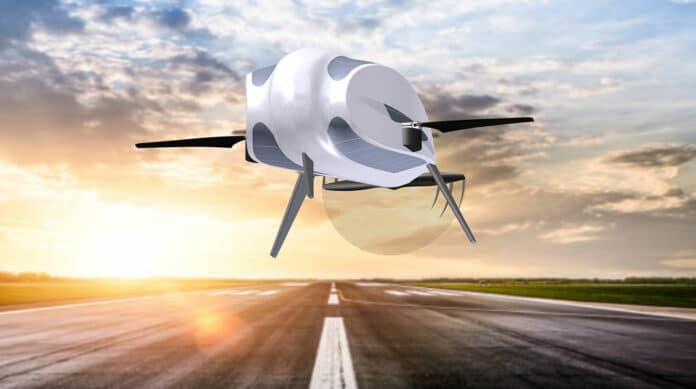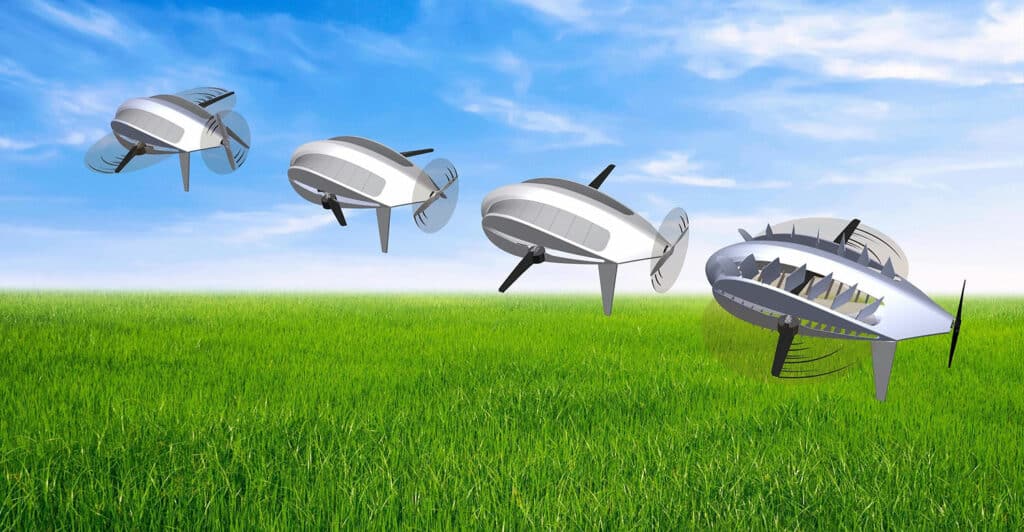
Blainjett Aviation announced that initial testing of its hemi-rotor aerodynamic concept has confirmed its potential to deliver faster, more efficient performance in VTOL aircraft. Subscale tests demonstrated the novel configuration’s net positive lift and low drag through the ascent/hover, cruise, and descent/hover phases of flight.
The startup is applying the hemi-rotor concept to a subscale drone as part of a path to demonstrating that the configuration can scale to larger unmanned or manned aircraft in eVTOL applications from package delivery and cargo to transport and tactical military roles. Blainjett’s hemi-rotor design situates familiar vertical lift rotors partially inside opposite sides of an enclosed fuselage. The airfoil-shaped fuselage also houses a pair of electric motors to drive the lift-rotors. Situated in the empennage above an inverted V-tail, the third motor powers a pusher prop.
In a hover, conventional open-rotors generate an even amount of lift all the way around. But when a traditional rotorcraft flies forward, its rotor blades both advances forward into the relative wind and retreat from it during rotation. This yields a dissymmetry of lift on opposing sides of the rotor arc, eventually creating a hard speed limit.

Blainjett solves the problem by enclosing the inner half of each rotor disc within the aircraft fuselage. The fuselage incorporates an inner hover door and a series of top and bottom vents to facilitate pitch and yaw control while in hover. Roll control is affected by power inputs to the mid-fuselage lift-rotors.
As the Blainjett’s subscale prototype transitions from hover to forward flight with thrust from its pusher-prop, its upper vent doors close, and the retreating rotor blades are shielded from the relative wind, negating drag, loss of lift, and the eventual negative lift that would occur at high speeds. The aerodynamic fuselage, as well as the advancing blades, in contrast, progressively produce lift. This allows the rotors to be slowed and stopped to a straight or swept-wing fixed position as forward speed increases.
In this configuration, the rotors become fully articulating wings with super low drag and therefore are super-efficient in forward flight. They can actively sweep backward, rotating in reverse for more drag reduction in the highest speed flight mode. The speed limitations imposed by the drag and lift-dissymmetry of compound rotor designs are dispensed without the complexity, drag, and weight penalties of familiar tilt-rotor aircraft.
The tests of the hemi-rotor prototype in different phases of the flight showed expected to lift and drag profiles for the semi-enclosed rotors in both spinning and fixed modes. Subscale testing will continue with V2 prototypes this Fall, evaluating enclosed and open-body hemi-rotorcraft designs employing Blainjett’s proprietary DVP technology. Blainjett is seeking potential manufacturing partners to help scale the concept and validate the design IP.
Blainjett’s hemi-rotor concept promises faster, more efficient VTOL performance
Source: Tambay News

0 Comments